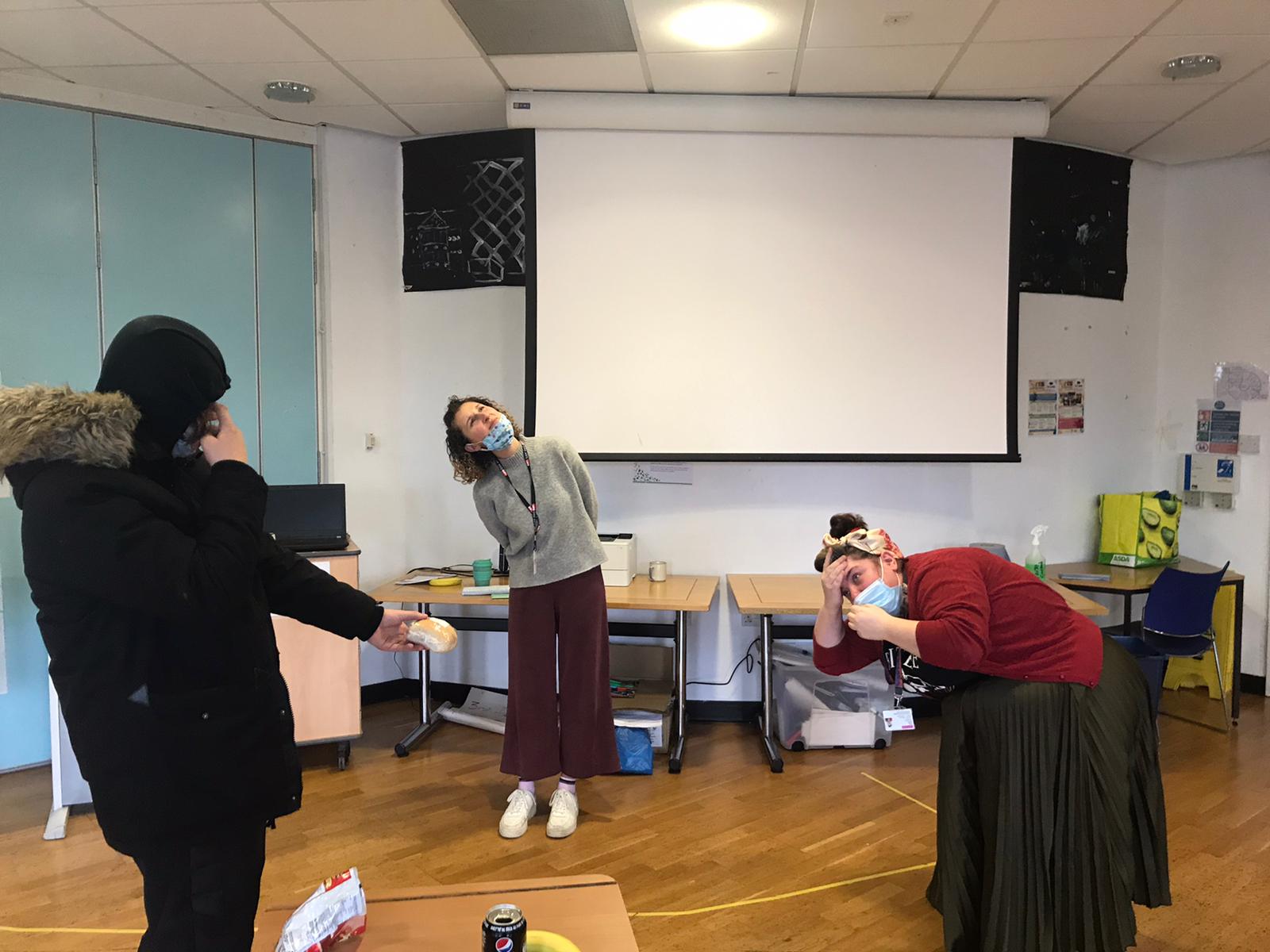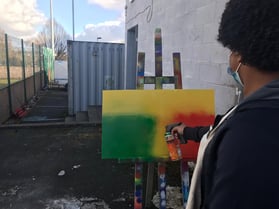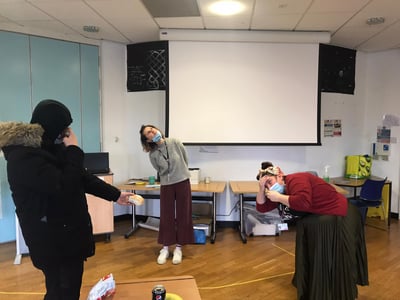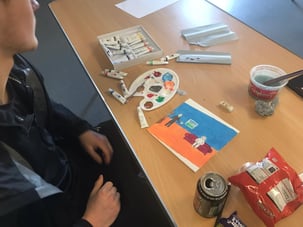
Top Tips on delivering Arts Award in secure or restricted settings
BY: Guest Writer
05 Jul 2021
We are aware that it can sometimes be challenging to collect and collate evidence for young people’s Arts Award portfolios when you are working in a restricted setting such as a prison, secure unit or criminal justice setting. This week we hear from Rebecca Friel, CEO of Trinity Champion Centre Odd Arts who answers some common questions on delivering Arts Award in restricted settings.
Odd Arts is an award-winning charity that transforms lives with theatre & arts that challenges and inspires. Odd Arts aims to reduce risk of (re) offending, build more cohesive and safer communities, improve mental wellbeing including increased confidence and self-worth, improve work-based skills through accreditation, communication skills and therapeutic learning and increase access and engagement to the arts and culture for disadvantaged groups.
 How do I enable young people to explore or research the wider arts, artists or arts opinions when they can’t ‘access’ the outside world or internet?
How do I enable young people to explore or research the wider arts, artists or arts opinions when they can’t ‘access’ the outside world or internet?
Use your networks! You may be an individual or organisation, but if you’re involved in Arts Award, the likelihood is that you’ll be connected to the wider arts community. Young people may want to interview artists, explore certain artforms or opportunities, or experience the arts first hand and at first this can seem impossible. However, you can still enable young people the autonomy to develop their own curiosity, themes and questions by utilising social media and personal arts connections to connect them with a wealth of opinion and activity. For example, one young person we once worked with in a secure unit anonymously wrote a letter requesting information on a specific interest which we were able to share on social media. We tagged local and national artists and arts organisations and passed it around our own creative networks. By calling on people to engage in social action and responsibility we had immediate, detailed responses which provided young people with more information than we initially hoped for!
We have used this technique at all levels of Arts Award and not only does it provide young people with the evidence needed for their learning, experience and portfolio, but vitally it reconnects them with the wider world that they might otherwise be locked away from. This can also be done with surveys, and even feedback on their own arts work without needing to give away a young person’s location or identity. This type of connection with the outside world can help boost a young person’s feeling of pride, self-worth and existence!
 Another way to provide the opportunity for learning and research is by creating your own pool of knowledge from the secure environment you might be based within. It’s amazing how much one ‘community’ might know just by pooling knowledge together, without needing the internet or a library. For example, we worked with a young man in a prison who wanted to know more about an artist he admired. To avoid our team having to print off pages of ‘Wikipedia’ which was a) not his own research and b) not very inspiring, he decided to find out what knowledge already existed from within those people that surrounded him. He conducted surveys and one-to-one interviews with other prisoners and staff within the prison. People were able to share opinions, find out more if it sparked conversation, and most importantly the process improved relations with peers and staff. From the information and opinions shared he gained an increase in knowledge and also connection to others who shared his interest or passion! This is an excellent way to also build confidence and communication skills and can be used at all levels of Arts Award.
Another way to provide the opportunity for learning and research is by creating your own pool of knowledge from the secure environment you might be based within. It’s amazing how much one ‘community’ might know just by pooling knowledge together, without needing the internet or a library. For example, we worked with a young man in a prison who wanted to know more about an artist he admired. To avoid our team having to print off pages of ‘Wikipedia’ which was a) not his own research and b) not very inspiring, he decided to find out what knowledge already existed from within those people that surrounded him. He conducted surveys and one-to-one interviews with other prisoners and staff within the prison. People were able to share opinions, find out more if it sparked conversation, and most importantly the process improved relations with peers and staff. From the information and opinions shared he gained an increase in knowledge and also connection to others who shared his interest or passion! This is an excellent way to also build confidence and communication skills and can be used at all levels of Arts Award.
How do I evidence participation if I can’t take a camera or recording equipment into the setting?
It’s great to be able to document engagement through photos, video and audio, but the fact that you’re reading this guidance implies that this is probably a lot trickier for you and all of us working in secure or restricted environments. Below are a few options to overcome this:
- Ask participants to draw and sketch what they did with speech and thought bubbles
- Ask other participants to comment on how one another did
- Ask staff for personal testimonials on how each individual did
- Save arts activity ‘scraps’ (post it notes, plans, rough tasks, materials) and create a collage of material evidence with comments from the participant on what happened
- If you have access to recording equipment but identity must not be shared outside of your setting, then you can photograph hands/backs or audio-record the session. If you’re not allowed to bring in any recording equipment then check out whether some ‘cleared’ equipment exists within the centre. Internal staff might then be able to take these non-identifying pictures on your behalf.
- Allow the young person to personalise their non-identifiable photos. For example, encourage them to draw arrows and comments
 How can I provide a high-quality arts audience experience when participants are in secure settings?
How can I provide a high-quality arts audience experience when participants are in secure settings?
One of the obvious challenges for delivering Arts Award in secure institutions is that visits ‘out’ are prohibited in most circumstances. So, the next obvious thing is to bring the arts ‘in’! Below are three ideas of how this can be done in a way that maintains interaction, experience and excitement:
- Commission professional artists or performers for private showcases within secure settings. We know this is sometimes financially not feasible, and Odd Arts is at an advantage here because we have a number of in-house professional theatre performances and actors that we invite to perform existing pieces or develop small-scale (lower cost) versions for secure settings. However, it’s also definitely worth contacting your local mainstream arts venues who may be able to provide this type of experience through their own ‘participation’ schemes and be keen to do so! For artists and arts organisations new to this type of environment, on top of the usual safeguarding and vetting you may want to provide them with ‘top tips’ for entering secure environments to prepare them for logistics around the workshop. If you think that the young people you’re working with may have additional needs and experiences that require artists with a higher level of understanding of their circumstances, there is a wealth of organisations and individuals that specialise in arts in criminal justice. By contacting the National Arts Alliance for Criminal Justice you can find out lots more.
- Create your own exhibition! Going back to the previous idea that we already have our own creative networks, here is another opportunity to use them. Are there hidden arts enthusiasts, performers, musicians, comedians or poets amongst the staff in the centre you work in? We always remind young people that reviewing the arts is about forming an opinion, and not necessarily needing to like it! If young people think something is ‘terrible’ we challenge them to articulate what aspects they dislike and how it could be better. If you do use staff’s own art it’s worth some personal preparation to deal with potentially negative reviews in advance.
 Start thinking early on about providing an audience or review experience. If you know from the start that you’ll face barriers accessing high-quality arts experiences for young people to review then it’s worth planning it into many other aspects of their Arts Award (and wider) activities. For example, you could create an exhibition of the young people’s work for them to peer review; you could ask any creative facilitators whether they have any arts they can offer for review; you could speak to a wider enrichment or education team to see if any activities can be expanded on. Perhaps young people are completing different levels of Arts Award, could the Unit 1 Arts Challenge for Silver of one young person be tied into the Bronze Part B: Explore the arts as an audience member for another? All these things are possible but made a lot more difficult if you don’t start planning this from the start.
Start thinking early on about providing an audience or review experience. If you know from the start that you’ll face barriers accessing high-quality arts experiences for young people to review then it’s worth planning it into many other aspects of their Arts Award (and wider) activities. For example, you could create an exhibition of the young people’s work for them to peer review; you could ask any creative facilitators whether they have any arts they can offer for review; you could speak to a wider enrichment or education team to see if any activities can be expanded on. Perhaps young people are completing different levels of Arts Award, could the Unit 1 Arts Challenge for Silver of one young person be tied into the Bronze Part B: Explore the arts as an audience member for another? All these things are possible but made a lot more difficult if you don’t start planning this from the start.
For more information about Odd Arts please visit www.oddarts.co.uk and see https://issuu.com/oddarts/docs/annual_report_3 for our most recent annual report

.jpg)

Comments & Replies